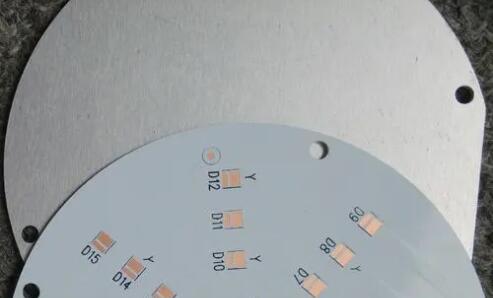Aluminum clad copper boardis the base material used in the manufacture of PCB aluminum base board.It mainly plays the role of interconnection, insulation and support for PCB aluminum base boards. It has a great influence on the transmission rate,energy loss and characteristic impedance of signals in the circuit.
The performance, quality, machinability, manufacturing level, manufacturing cost and long-term reliability and stability ofPCB aluminum base board depends to a large extent on aluminum-clad copper boards. Aluminum-based circuit boards have excellent electrical performance, heat dissipation capacity, electromagnetic shielding, high dielectric strength and bending resistance. As a metal core PCB, whether it is single-layer, double-layer or multilayer aluminum-based circuit boards, they have many similarities in manufacturing technology with FR4 circuit boards, such as etching thick copper foil, aluminum surface etching protection, aluminum board manufacturing and solder mask printing. However, as an advanced PCB, aluminum-based circuit boards still have special aspects in the manufacturing process, which require strict and effective management and control. So, what are the precautions and manufacturing difficulties in the production of aluminum-based circuit boards?

Mechanical processing:
Drilling of aluminum substrate is possible, but there must be no burrs inside the drilled holes, which will affect the pressure test. Milling the outer profile is very difficult.
Punching the outer profile requires the use of high-grade molds. Mold making is very skillful and is one of the difficulties of aluminum substrate. After the outer profile is punched, the edges must be very neat, without any burrs, and the solder mask layer on the edge of the board must not be damaged. Usually, a manipulator mold is used. The holes are punched from the line, and the outer profile is punched from the aluminum surface. There are many skills in the punching process, such as the force applied to the circuit board during punching is upper shear and lower pull.
After the outer profile is punched, the warpage of the board should be less than 0.5%.
The entire production process does not allow the aluminum surface to be scratched:
The aluminum surface will be discolored and blackened if it is touched by hand or by certain chemicals. This is absolutely unacceptable. Some customers do not accept the re-grinding of the aluminum surface, so not touching or contacting the aluminum surface during the whole process is one of the difficulties in the production of aluminum circuit boards.
Some processes use passivation, Some put protective films on before and after hot air leveling (spraying tin). There are many tricks, like the Eight Immortals crossing the sea, each showing their magical powers.
Over pressure test:
Communication power aluminum substrate requires 100% high voltage test, some customers require DC, some require AC, voltage requirements of 1500V, 1600V, time of 5 seconds, 10 seconds, 100% printed board for testing.
Any dirt, burrs on the edge of holes and aluminum substrate, line serrations, and damage to any insulation layer on the board surface will cause the high voltage test to catch fire, leak electricity, and break down.
The test board is delaminated and blistered, and it will be rejected.
Thick copper foil etching:
Aluminum circuit boards are commonly used in power devices with high power density, therefore the copper foil is relatively thick.
When the copper foil thickness is 3oz or greater, etching the copper foil requires trace width compensation. Otherwise, the linewidth after etching will be out of tolerance.
Therefore, in order to ensure the best linewidth/spacing and impedance control that can meet the design requirements, the following work must be completed in advance:
Linewidth compensation should be properly designed;
The influence of line manufacturing on line width/spacing should be eliminated;
Etching factor and reagent parameters should be strictly controlled.
Solder mask printing:
Due to the effect of thick copper foil,solder mask printing is considered to be a manufacturing difficulty in the manufacture of aluminum circuit boards.
If the copper thickness of the traces after image etching is too large,there will be a large difference between the trace surface and the substrate, and the solder mask layer will become difficult.
In order to ensure the smooth progress of solder mask printing,high-quality performance solder resist should be used,two times solder mask printing should be used, and if necessary, the manufacturing method of filling resin first and then printing solder mask can be used.
Mechanical manufacturing:
Mechanical manufacturing of aluminum circuit boards includes mechanical drilling, milling and forming and V-cutting. Burrs are often left in the internal vias, which will reduce the electrical strength.
Therefore, in order to ensure high-quality mechanical manufacturing, small batch production, electric milling cutters and professional milling cutters should be selected. The process technology and pattern should be controlled during the molding process. The drilling parameters should be adjusted appropriately on the thick copper aluminum circuit board to prevent burrs.